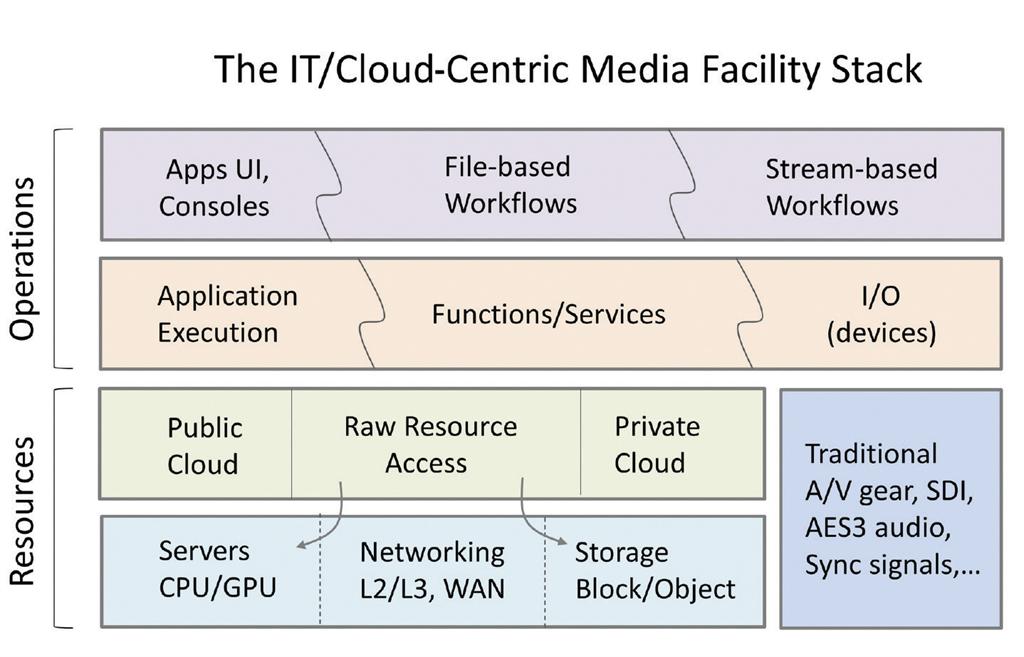The Move to the All-IT Facility

Al Kovalick
With the 2013 NAB Show behind us, what do the new product releases tell us about the future of the media facility? Many vendors gave lip service and vague references to “open IT” and the cloud in their brochures and press releases. From a nonscientific survey, about 3–5 percent of the 1,600 vendors had breakthrough products, meaningful advances in technology, and bold new ideas related to IT/IP/cloud.
Admittedly, I could not visit every booth. However, investigations were made of the usual suspects, plus many of the new arrivals.
There are three general types of products at the NAB Show: traditional AV products; traditional IT products (a minority of exhibiting vendors); and the newer hybrid breed having the DNA of both.
Hybrid products use combinations of IT/IP/cloud resources to provide media-focused solutions. This class of product/ solution ranges from minor use (i.e. file workflows) of IT/IP/cloud resources to products based solely on these precepts (i.e. all ops run from a cloud). These hybrid products are the foundational elements for “the all-IT” media facility.
TECHNOLOGY FOUNDATIONS
What are the technology foundations for the all-IT media facility? Here are three areas that make up the majority share:
AV transport over Ethernet using LAN Layer 2 (MAC addressing) and Layer 3 (IP addressing). For both LAN and WAN transport, IP will be the common thread that joins all networks. Some of the features of the AV-networked campus are: real-time SDI-payload streaming, time and sync-aware nodes using IEEE-1588 Precision Time Protocol or similar (IEEE- 802.1AS, for example), frame- accurate stream switching, efficient file transfer, WAN/internet connectivity and storage access. There will be variations on these themes, but pure SDI will be for special cases and become mostly legacy over time.
Web apps running in browsers will be de rigueur and installed desktop (.EXE) applications the exception. Sure, it will take time for installed apps to take a back seat. These methods will be common:
Public cloud SaaS media apps (and workflow suites) for MAM, editing, review and approval, logging and scheduling for starters. HTML5 will be the lingua franca for UI presentation.

Private servers running HTML5 Web apps. These are captive apps and executed under facility control.
User apps are installed on servers but accessed using virtual desktop methods including Citrix Remote Desktop, Microsoft VDI or other remote desktop methods. Using VDI, apps are accessible on “thin clients,” but executed on local servers or remote cloud servers. This is a good solution for legacy desktop apps not yet ported to HTML5. Technically, it’s not a Web app, but may be accessed from a browser in many cases.
Data Center and Cloud Ecosystems Components make up the third area. This includes:
• Servers, storage and networking as isolated components;
• Public and private IaaS compute (servers) and storage offerings (file, block, object). For example, Amazon’s AWS and Google’s GCE cloud resources for hire and the private/local offerings from IBM, HP, NetApp, VMware, EMC, Cisco and others.
• Cloud services such as transcoding, ingest, video processing and distribution. The services are accessed via APIs and/ or configuration UIs as required. Examples are: Encoding.com, AWS Elastic Transcoder, MediaSilo workflow APIs and many others.
• Cloud monitoring, accounting, automation and integration systems. Ex, Hyperic, RightScale, Sequencia and others.
TYING IT ALL TOGETHER
Some may quarrel that there are roadblocks to relying on the basics outlined above. Fair enough. Today there are real obstacles—public cloud access bandwidth, security, real-time functionality, reliability and available solutions to name a few. But each of these issues is being chipped away by vendors and industry groups working like beavers to deliver dependable, interoperable solutions.
Fig. 1 outlines a view of the future media facility based on IT and cloud principles. It assumes a level of technological maturity not available in 2013 for the majority of systems. That said, there are many workflows that can be implemented 100 percent using IT/cloud principles today.
The figure has four generic layers. The lowest layer describes the compute, storage and network resources available to the upper layers. Layer 2 shows these resources as a cloud formation or as individual resources applied as needed. The choice of private versus public cloud will depend on a host of variables not considered here. The private on-campus versions will seamlessly connect to the public versions over secure IP channels. How resources are applied will depend on the workflows demanded. For example, local compute, remote archive and public SaaS are real possibilities. Keep in mind that a local cloud has many of the automation and agility aspects of its public cousin, but under tighter control and security.
Layer 3 illustrates the application, services, functional executions and I/O. The input/output section relates to cameras, monitors, network links and devices of all kinds.
The top layer is where the apps (UI) reside and workflows are defined and orchestrated. Workflows come in three flavors; file-based, real-time stream-based, and hybrids. File-based is mature today (non-cloud versions). Stream-based is just starting to gain traction, waiting for the standards and best practices to be solidified before its feature set is complete.
The diagram also shows a stack of traditional AV infrastructure coexisting with IT. The fade to all IT will take time and there will be sweet spots for pure AV for many years. Realistically, many facilities will have the integrated elements of cameras, displays, AV consoles, lighting, mics, speakers and more. These elements are not strictly IT-based, but their control and some I/O will become such.
This diagram could be partitioned into as many domains as needed to create superset systems that have the reach, reliability and flexibility required. No one expects that a major multi-channel broadcast facility will be built as one monster cloud-centric system for many years. Rather, facilities and event trucks will be founded on the principles in the figure, but sized, divided and allocated accordingly.
In future columns, this architecture will be investigated in more depth.
Al Kovalick is the founder of Media Systems consulting in Silicon Valley. He is the author of “Video Systems in an IT Environment (2nd ed).” He is a frequent speaker at industry events and a SMPTE Fellow. For a complete bio and contact information, visitwww.theAVITbook.com.
Get the TV Tech Newsletter
The professional video industry's #1 source for news, trends and product and tech information. Sign up below.

